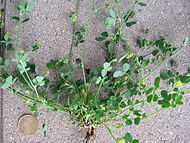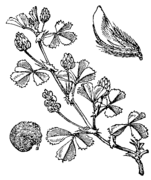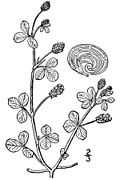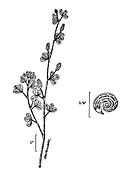Medicago lupulina
| Medicago lupulina | |
|---|---|
 | |
| Scientific classification | |
| Kingdom: | Plantae |
| (unranked): | Angiosperms |
| (unranked): | Eudicots |
| (unranked): | Rosids |
| Order: | Fabales |
| Family: | Fabaceae |
| Subfamily: | Faboideae |
| Tribe: | Trifolieae |
| Genus: | Medicago |
| Species: | M. lupulina |
| Binomial name | |
| Medicago lupulina L. | |
Medicago lupulina (black medic, sometimes spelled medick or meddick; also known as black hay, black nonesuch, blackweed, etc.[1][2]) is a summer annual or perennial plant usually considered a weed. It has a tap root. Like other legumes, it has three leaflets; its center leaflet is on a separate petiole. As with other legumes, nitrogen-fixing bacteria, known as rhizobia, are found in nodules on the roots.
Description
Medicago lupulina is an annual or bi-annual plant, sometimes long-lived thanks to adventitious buds on the roots. The plant measures from 15 to 60 cm in height, with fine stems often lying flat at the beginning of growth and later erecting. The nodes bear three leaves, carried by a long petiole and have oval leaflets, partially toothed towards the tip. This species has very small yellow flowers are grouped in tight bunches. The fruit is a pod that does not open upon maturation, of a little arched form and bearing a single seed.
It is sometimes confused with other plants that have small leaves divided into three leaflets and small yellow flowers, such as members of:
- the clover genus, like hop trefoil and lesser hop trefoil
- the false shamrock genus, like yellow woodsorrel
Distribution
This plant can be seen through the old world: all of Europe, a great part of Asia, including China, Korea and Taiwan, as well as the Indian sub-continent, North Africa, the islands of the Atlantic (the Canaries, Madeira) and throughout the United States, including Hawaii.
It thrives in dry limestone grounds and coastal sand dunes, where it suffers less competition from the other plants. It is relatively cold resistant and can be seen in mountains up to 1800m.
Use
Medicago lupulina is sometimes used as a fodder plant. While being of good value, it isn't a very productive fodder. It is sometimes used in the composition of artificial meadows, especially when implanted in dry lands. It is a common sight in natural pastures. It is also one of the flowers that can be used to create honey.
Photographs
-

flower
-

leaves and flowers
-

flowers wilting after pollenation
-

unripe seed pods (green)
-

ripe seed pods (black)
-
seeds
-
Root with nodules
-

ground-hugging whole plants
-

an entire uprooted plant
Illustrations
-

M. lupulina (bottom)—
M. arabica (top) -

-

-

References
External links
- Entry in the Linnean herbarium
- A mention in 1866 from the Correspondence of Charles Darwin: "Several years ago I protected Medicago lupulina from insects, & its fertility was much impaired, but not wholly prevented."
- WeedAlert.com's listing for Medicago lupulina
- Effect of Black Medic Cover Crop on N Supplying Power of Prairie Soils
- Wikispecies entry
| Wikimedia Commons has media related to Medicago lupulina. |

